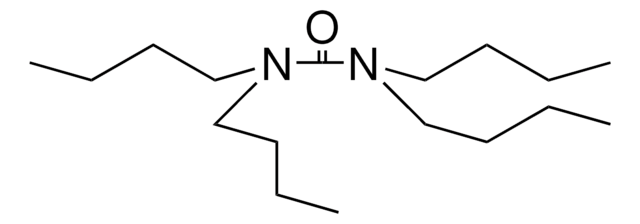471232
Dibutylamine
≥99.5%
Sinónimos:
N,N-Di-n-butylamine, N-Butyl-1-butanamine, n-Dibutylamine, Di-n-butylamine
About This Item
Productos recomendados
densidad de vapor
4.46 (vs air)
Nivel de calidad
presión de vapor
1.9 mmHg ( 20 °C)
Ensayo
≥99.5%
Formulario
liquid
temp. de autoignición
594 °F
lim. expl.
10 %
índice de refracción
n20/D 1.417 (lit.)
pH
11.1 (20 °C, 1 g/L)
bp
159 °C (lit.)
mp
−62 °C (lit.)
solubilidad
water: soluble 3.8 g/L at 20 °C
densidad
0.767 g/mL at 25 °C (lit.)
grupo funcional
amine
cadena SMILES
CCCCNCCCC
InChI
1S/C8H19N/c1-3-5-7-9-8-6-4-2/h9H,3-8H2,1-2H3
Clave InChI
JQVDAXLFBXTEQA-UHFFFAOYSA-N
¿Está buscando productos similares? Visita Guía de comparación de productos
Categorías relacionadas
Descripción general
Aplicación
- N, N
- -Dibutyl-4-methylaniline by Pd-catalyzed Buchwald-Hartwig amination reaction with aryl chlorides and bromides.
- N,N-Dibutylacetamide by acetylation reaction with isopropenyl acetate.
It can also be used as:
- A strong hindered base in the different elimination reactions.
- An organocatalyst to synthesize annulated pyrano[2,3-d]pyrimidine derivatives via multicomponent condensation reaction of aromatic aldehydes, malononitrile, and barbituric acid.
Palabra de señalización
Danger
Frases de peligro
Clasificaciones de peligro
Acute Tox. 2 Inhalation - Acute Tox. 3 Dermal - Acute Tox. 4 Oral - Eye Dam. 1 - Flam. Liq. 3 - Skin Corr. 1A
Código de clase de almacenamiento
3 - Flammable liquids
Clase de riesgo para el agua (WGK)
WGK 1
Punto de inflamabilidad (°F)
104.9 °F - closed cup
Punto de inflamabilidad (°C)
40.5 °C - closed cup
Equipo de protección personal
Eyeshields, Faceshields, Gloves, type ABEK (EN14387) respirator filter
Elija entre una de las versiones más recientes:
¿Ya tiene este producto?
Encuentre la documentación para los productos que ha comprado recientemente en la Biblioteca de documentos.
Los clientes también vieron
Global Trade Item Number
| Número de referencia del producto (SKU) | GTIN |
|---|---|
| 471232-500ML | 4061832359663 |
| 471232-100ML | 4061832359649 |
| 471232-18L | 4061836827021 |
| 471232-1L | 4061832359656 |
Nuestro equipo de científicos tiene experiencia en todas las áreas de investigación: Ciencias de la vida, Ciencia de los materiales, Síntesis química, Cromatografía, Analítica y muchas otras.
Póngase en contacto con el Servicio técnico
















